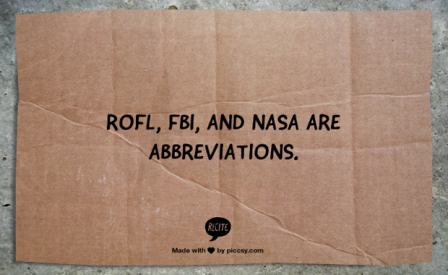Abbreviations and Contractions
Abbreviations and contractions of words both serve to shorten a word, but while abbreviations omit the last few letters of the word, contractions omit letters in the middle of the word. Abbreviations and contractions have become even more common with the internet, texting, and the need to keep messaging and posting text to a minimum.
Here is an interesting recent history from Wikipedia about how abbreviations and contractions have evolved:
“Minimization of punctuation in typewritten material became economically desirable in the 1960s and 1970s for the many users of carbon-film ribbons since a period or comma consumed the same length of non-reusable expensive ribbon as did a capital letter.
Widespread use of electronic communication through mobile phones and the Internet during the 1990s allowed for a marked rise in colloquial abbreviation. This was due largely to increasing popularity of textual communication services such as instant- and text messaging. SMS, for instance, supports message lengths of 160 characters at most. This brevity gave rise to an informal abbreviation scheme sometimes called Textese, with which 10% or more of the words in a typical SMS message are abbreviated… Twitter began driving abbreviation use with 140 character message limits.”
When a word is abbreviated, there is a period at the end of the word to show that there are missing letters at the end of the word. i.e.: extension ext.
abbreviations and contractions examples

Abbreviations
Professor Prof.
extension ext.
Contractions
Doctor Dr.
Saint St.
A contraction can also be an abbreviated form of more than one word. In contractions that represent more than one word, the letters that have been omitted should be replaced with an apostrophe
She’ll She will
They’ve They have
Wouldn’t Would not
Abbreviations and contractions mostly adhere to certain rules. Exceptions apply mainly to the usage of abbreviations:
1. Use periods in most abbreviations that contain lowercase letters. e.g. c.o.d.
2. Do not use periods for titles, time zones, businesses and organization names, and acronyms. IBM, NASA, CIA, UN, EST.
3. In the United States, periods are not used for street names and road signs. The U.S. Postal Service and the official manual for traffic signs rules that mailing addresses and traffic and road signage do not use periods. Periods should not be used with abbreviations on road signs street names, etc. For example:
Fifth Ave
110th St
Broward Blvd
4. You capitalize abbreviations if you capitalize the original word because they are proper nouns. For example. United Nations = UN. Common nouns are not capitalized. For example: air conditioner – ac; compact disc – cd.
Abbreviations and contractions of words both serve to shorten a word, but while abbreviations omit the last few letters of the word, contractions omit letters in the middle of the word.



















